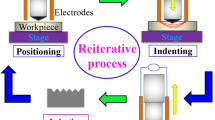Results of studying the effect of component surface preparation on coating adhesive strength with a substrate are presented. A new method of surface preparation for plasma spraying is proposed that makes it possible to reduce worn component restoration specific costs and labor intensity, as well as to improve coating quality. A distinctive feature of the method proposed is the effect on treated surface of a thermal-abrasive jet with simultaneous surface heating that provides good coating adhesive strength with a component surface.










Similar content being viewed by others
References
A. Khasui and O. Morigaki, Surfacing and Deposition (editors I. S. Stepan and N. G. Shesterkin), [translated from Japanese, V. N. Popov], Mashinotroenie, Moscow (1985).
A. I. Sidorov, Component Restoration by Deposition and Surfacing [in Russian], Mashinotroenie, Moscow (1987).
V. V. Kudinov and G. V. Bobrov, Coating Application by Deposition. Theory, Technology and Equipment [in Russian], Metallurgiya, Moscow (1992).
G. N. Lashchenko, Plasma hardening and Deposition [in Russian], Ékotekhnologiya, Kiev (2003).
N. A. Sosnin, S. A. Ermakov, and P. A. Topolyanskii, Plasma Coatings with a Nanocrystalline and Amorphous Structure [in Russian], Izd. Politekhn. Univ., St. Petersburg (2008).
V. I. kalita and D. I. Komlev, Plasma Coatings with Nanocrystalline and Amorphous Structure [in Russian], Lider M, Moscow (2008).
I. N. Kravchenko, M. A. Glinskii, S. V. Kvartsev, et al., Resource Saving Technology During Repair of Refrabricated Equipment [in Russian], INFRA-M, Moscow 2021. DOI: https://doi.org/10.12737/1083289.
A. F. Puzryakov, I. N. Kravchenko, I. K. Sokolov, et al., Technology for Application of Wear-Resistant Coatings with Increased Strength, [in Russian], Éko-Press, Moscow (2013).
L. Kh. Baldaev, V. N. Borisov, V. A. Vakhalin, et al, Gas-Thermal Deposition, 2nd Ed. [in Russian], Staraya Basmannaya, Moscow (2015).
A. I. Kovtunov, I. S. Nesterenko, and Yu. Yu. Yurikov, “Effect of base metal warm-up temperature on coating strength and adhesion with gas-thermal deposition,” in: Innovative introductions in the field of technical science, coll. sci. work, Évensis, Moscow 2018).
O. A. Sharaya, A. G. Gastukhov, and I. N. Kravchenko, Surface Engineering of Strengthened Components [in Russian], INFRA- M, Moscow (2020). DOI: https://doi.org/10.12737/1031713.
A. E. Provolotskii, Jet-Abrasive Treatment of Machine Components [in Russian], Tekhnika, Kiev (1989).
A. E. Provolotskii, “Mechanization of component finishing with use of jet-abrasive treatment,” Mekhan. Avtomat. Proizvod., No. 5, 7 – 10 (1990).
M. N. Baranov,M. G. Isupov, and G. P. Isupov, “Strength indices for treated material with jet-abrasive treatment,” Vestnik Mashin., No. 5, 62 – 66 (2009).
A. A. Andilakhai and F. V. Novikov, “Theoretical and experimental study of jet-abrasive treatment dynamics,” Vestnik Priazov. Gos. Tekhn., Univ., No. 20, 206 – 212 (2010).
O. V. Zakharov L. V. Khudobin, N. I. Vetkasov, et. al., “Jet-abrasive treatment of large components,” Vestnik Mashin., No. 3, 79 – 81 (2016).
A. A. Andrilakhai, “Theoretical analysis of component jet-abrasive treatment parameters,” Vestn. Nats. Tekhn. Univ. KhPI, No. 1, 15 – 22 (2009).
F. V. Novikov and A. A. Andrilakhai, “Theroetical analysis of forced stress parameters of jet-abrasive treatment,” Nauch. Tr. Donetsk. Nats. Tekhn. Univ. Ser. Mashin. Mashinoved., No. 7 (166) 46 – 53 (2010).
V. S. Shirshov, “Study of the effect of surface treatment parameters for metal structures on coating adhesive strength with s base,” Svaroch. Proizvod., No. 7, 23 – 26 (2012).
F. V. Novikov, A. A. Andilakhai,, and O. S. Klenov, Determination of forced stress parameters for nongferrous metal component machining processes,” Vestn. Priazov. Gos. Tekhn. Univ. Ser. Tekhn. Nauk, No. 26, 174 – 182 (2013).
S. V. Kvartsev, RF Patent 92238, MPK H 01 J 1/02. Plasmatron for plasma deposition. No. 2009123241/22; Claim 06.18.2009; Publ. 03.10.2010, Bull. No. 7.
S. V. Kvartsev, M. N. Erofeev, I. V. Kvartseva, and N. N. Kravchenko, RF Patent 2737909, MPK B24C 1/00. Surface preparation method for wear-resistant coating application, No. 2020121911; Claim 07.02.2020; Publ. 12.04.2020, Bull. No. 34.
S. M. Muneer and M. Nadeera, “Wear characterization and microstructure evaluation of silicon carbide based nanocomposite coating using plasma spraying,” Materials Today : Proceedings, 5(11), Part 3, 23834 – 23843 (2018). DOI: https://doi.org/10.1016/j.matpr.2018.10.175.
A. F. Puzryakov, Theoretical Bases of Plasma Deposition technology [in Russian[, Izd. MGU im N. É. Bauman, Moscow (2008).
I. N. Kravchenko, T. A. Chekha, A. O. Fedorov, and A. F. Slivov, “Features of component surface preparation for deposition of wear-resistant plasma coatings,” Remont. Vosstan. Modern. No. 2, 27 – 32 (2020). DOI: https://doi.org/10.31044/1684-2561-2020-0-2-27-32.
I. N. Kravchenko, A. F. Slivov, V. M. Korneev, and Yu. V. Kataev, “Component surface cleaning during restoration,” Sel. Mekhan., No. 8, 38 – 40 (2019).
M. G. Isupov, “Prediction of metal removal during jet-abrasive treatment,” Izv. Vuz. Mashinostronenie, No. 6, 37 – 46 (2004).
M. G. Isupov, “Calculation of metal removal during jet-abrasive treatment,” Vestn. Donsk. Gos. Tekhn. Univ., 5(1), 84 – 88 (2005).
V. V. Klyuev, F. R. Sosnin, V. N. Filinov, et. al, Engineering Encyclopaedia, 2nd. ed [in Russian] Mshnistroenie, Moscow (2001).
A. I. Stroganov, A. S. Drobyshevskii, and A. B. Gots, “Effect of steel substrate roughness on plasma coating adhesive strength,” Poroshk. Metall., No. 10, 91 – 95 (1982).
V. A. Krasnyi and V. V. Maksarov, “Evaluation of the effect of surface roughness on increase in adhesive strength of a wear-resistant deposited coating,” Metalloobrabotka, No. 5(83), 47 – 51 (2014).
I. N. Kravchenko, S. V. Kartsev, and Yu. A. Kuznetsov, “Use of hot hydrocarbons in a plasma installation for application of wear-resistant coatings,” Refract. Ind. Ceram., 61(4), 399 – 403 (2020). DOI: https://doi.org/10.1007/s11148-020-00492-2.
Author information
Authors and Affiliations
Corresponding author
Additional information
Translated from Novye Ogneupory, No. 3, pp. 40 – 47, March, 2021.
Rights and permissions
About this article
Cite this article
Kravchenko, I.N., Kartsev, S.V., Velichko, S.A. et al. Effect of Component Surface Preparation on Coating Adhesive Strength during Plasma Spraying. Refract Ind Ceram 62, 168–174 (2021). https://doi.org/10.1007/s11148-021-00578-5
Received:
Published:
Issue Date:
DOI: https://doi.org/10.1007/s11148-021-00578-5




